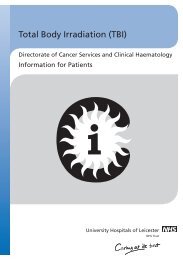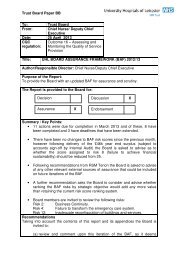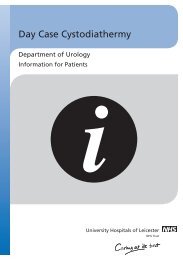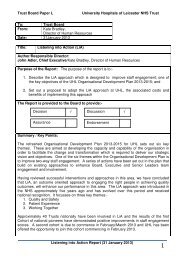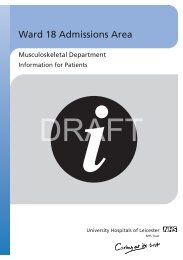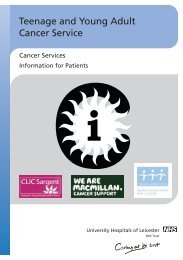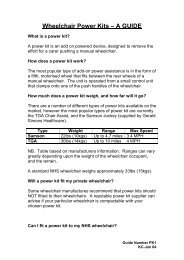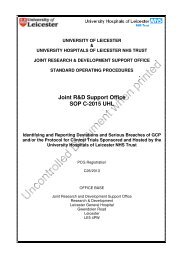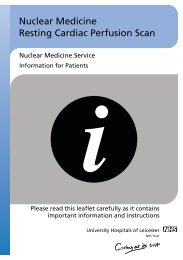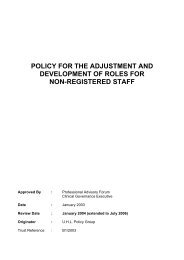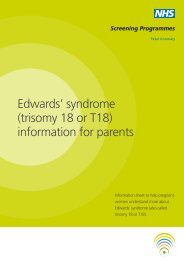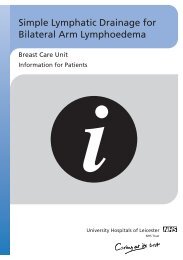Coronary Angioplasty and Stenting - Information for ... - Library
Coronary Angioplasty and Stenting - Information for ... - Library
Coronary Angioplasty and Stenting - Information for ... - Library
Create successful ePaper yourself
Turn your PDF publications into a flip-book with our unique Google optimized e-Paper software.
YOUR WOUNDLeave your dressing or your plaster on <strong>for</strong> 2 days after yourprocedure <strong>and</strong> then remove it <strong>and</strong> leave the puncture site exposedto heal. Some bruising <strong>and</strong> discolouration may develop at the sitebut it is not serious. Paracetamol can be taken <strong>for</strong> minordiscom<strong>for</strong>t. However, if at any stage you are concerned about yourwound site, may be it is very swollen or has an enlarging painfulbruise over it, please contact either your GP or the ward you stayed<strong>for</strong> advice.WHAT ABOUT MEDICATION FOR STENT IMPLANT?You will be prescribed a medicine called Clopidogrel, which stopsblood cells (platelets) sticking together on the stent implanted inyour coronary artery. You will be given specific instructions <strong>for</strong>how long you will need to take this <strong>for</strong>. The hospital pharmacy willprovide you with a supply <strong>for</strong> 1 month, so you will need to get arepeat prescription from your GP if you are required to take it <strong>for</strong>longer. Your doctor, nurse or pharmacist on the ward will adviseyou. You will need to continue to take aspirin as you have beendoing.INTRODUCTIONThis booklet has been developed to help you underst<strong>and</strong> what toexpect be<strong>for</strong>e, during <strong>and</strong> after your coronary angioplasty <strong>and</strong>stent implant. If you have any questions that the booklet does notanswer, please do not hesitate to ask the nursing or medical staffwho are looking after you.CORONARY ARTERY DISEASE<strong>Coronary</strong> artery disease is the term used to describe furring <strong>and</strong>narrowing of the arteries (blood vessels) in the heart that provideblood flow to the heart muscle. The gradual build up of fattymaterials in the inner lining of the arteries is the most commoncause of narrowing of the coronary arteries. Angina is the namegiven to the symptoms that happen when the build up is enough torestrict the blood flow down the artery <strong>and</strong> there<strong>for</strong>e the heartmuscle does not receive enough blood <strong>and</strong> oxygen. Thesesymptoms may include chest pain or discom<strong>for</strong>t as well asbreathlessness.Diagram of the Heart:ON DISCHARGEWhen you return home which should be within 1 or 2 daysfollowing your procedure, you should take it easy <strong>for</strong> at least 2days <strong>and</strong> slowly increase your activity. Ask your doctor or nurseabout returning to work as this often depends on your occupation,but the general rule is that we advise you to remain off work <strong>for</strong> 1week. Avoid lifting heavy objects <strong>and</strong> activities such as hoovering,mowing <strong>and</strong> lifting heavy shopping <strong>for</strong> 2 days <strong>and</strong> then return tonormal activity, as you feel able. <strong>In<strong>for</strong>mation</strong> is available on theward on lifestyle adjustment or through your local CardiacRehabilitation team.-9--2-



